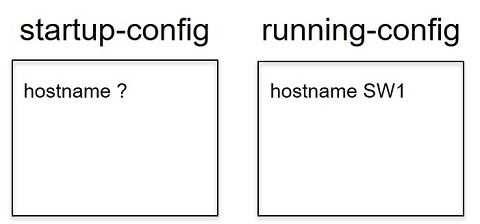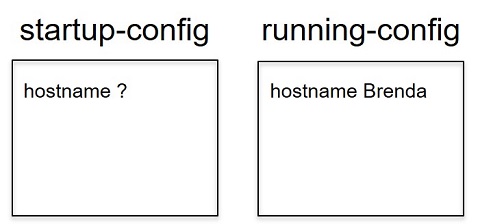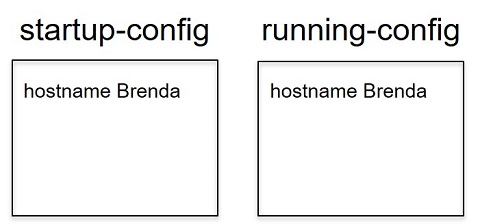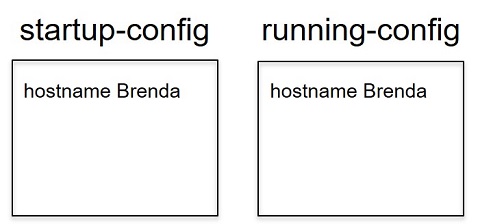A: Config Process
For #CCNA prep, we get used to a two-step process: change the configuration and use the copy run start command to save the configuration. However, what happens when you interleave some less-used commands around the same time?
The Answers:
D
Disclaimer before the Answer
Before you post to tell me that no one would ever issue the commands listed in this question in the order shown, let me make a few points.
- The goal is to be ready for the exam, and I could imagine a question that required the ability to analyze what’s happening in this question.
- One person who is still learning the commands could easily try this sequence
- Multiple engineers could be working at the same time and accidentally cause this sequence to happen!
Please take this one as an opportunity to learn and think, which is my intent. Anything that gets you one step closer to passing is good!
Background: Analysis of the Steps in the Question
To analyze this scenario, begin at the end, with the reload command. The sequence ends with a reload, along with the statement about all prompts answered with a “no.” That means:
If you have changed the running-config, the reload command causes IOS to ask you if you want to save the running-config to the startup-config before reloading, and the engineer answered “no.”
From that perspective, the switch uses the startup-config file as is at step 7.
Working backward from step 7, at what previous steps (if any) does the engineer save the configuration? Step 4, and step 4 only. None of the other steps issue a copy running-config startup-config command. So you need to figure out the hostname setting in the running-config file leading up to step 4.
Again working backward, this time from step 4, what do we know about the hostname setting in the running-config? Well, it has had a few values before step 4, but step 3 most recently configured the hostname Brenda command, setting the hostname in the running-config.
To summarize the key ideas:
- At step 3, the engineer sets the hostname to Brenda in the running-config file.
- At step 4, the engineer saves the running-config to the startup-config.
- No changes occur to the startup-config before step 7.
- The process at step 7 reloads the switch using the startup-config as is.
Figure 1: Hostname Settings to Begin the Question

Figure 2: Hostname After Step 3

Figure 3: Hostname Settings After Step 4

Figure 4: Hostname Settings After Reload


can you say me the mean of 200-301 ?
It’s the exam number of the new CCNA exam. see cisco.com/go/certifications
hello sir, good day
in mid february i’ve ordered the CCNA cert guide and then new cert specs came out and with a new book! so is it big diff between books or topics has change?, do i need the new books?, does the exam topics chanched?
thanks and best regards
Hi Basem,
Short answer is yes, you’ll need the new books. FYI, many bookstores would rather refund your money on the old books in those kinds of cases, in hopes of making you a good customer. Bookstores rely on regular customers!
That said, check out this post for lots of detail: https://www.certskills.com/how-to-use-my-ccna-200-301-books-if-you-transitioned-from-the-200-125-books/
The new exam has about 30% new topics vs the old exams.
Hello, the first thing to tell you that I am delighted with the blog, is helping me a lot to face the course.
My question is the following, I have currently bought the new ccna 200-301 vol1 and vol 2 and I also have the previous routing and switching packet tracer labs separated by ccna1 ccna2 ccna3 and ccn4. How could I know which laboratories would correspond to the chapters of the new ccna 200-301 vol1 and vol2 ??? ‘
Greetings and a thousands thanks.
Hi Patrik,
Glad you like the blog! Thanks for the note.
I think you’ll have to do the matching from your other resource (the academy lab books) to my Cert Guides just by thinking about the topics. I’d say flip to the table-of-contents of my books, and then look at the labs in your other books, maybe the table of contents in those as well. Then scan and compare. But I don’t have anything that connects the two. Sorry about that!
HI Sir
does online bookstore refund the money like amazon?
because i just bought the book before the new version comes.
Hi,
Bookstores do often have a generous return policy – you should definitely investigate it with the bookseller.
Wendell
Hello sir, wonderful bog and very helpful as well, btw sir for this article , i cant really see the question above all i see is that :
“For #CCNA prep, we get used to a two-step process: change the configuration and use the copy run start command to save the configuration. However, what happens when you interleave some less-used commands around the same time?”
Is this the whole question ? if it is , i cant get my head around on what does this line means :
“However, what happens when you interleave some less-used commands around the same time?”
Hello Zuhail, hope you´re ok, where´s the Question of this lab? or there´s a lab file or something? I´d like to get some practice but can´t find the main question.
thanks in advance
Hey sir, i have found the question . Thanks alot!
I can not believe that you help people personally even for free and your books are amazing!!
Love from India/
Hello, The images appear to be not working unfortunately
Thanks for the notice! Should be all good now.
Thank you for this blog, Wendell. It’s very helpful while studying for the CCNA in 2025.
For this question, I’d argue that you could easily interpret the answer as B, SW1. This is because the engineer would need to first navigate from user mode, to privileged mode, and, finally, to global configuration mode to issue the first hostname command. With that in mind, we can re-consider the question:
“A switch currently uses hostname SW1. An engineer connects to the switch and then does the following in order:
…
”
We see that after connecting the engineering immediately tries to resolve the “hostname” command, which, unless the switch is configured otherwise, will fail if the engineer is not in the global configuration mode. Furthermore, all subsequent commands modify the switch and require modes other than user mode, so all of the commands will fail.
Let me know if I missed something. Thanks.
Hi Skye,
I agree, you could interpret the question as you describe.
I’m thinking that in the original question, from 7 years ago, I was thinking in terms of each step expecting a beginning thought of “after navigating to the appropriate mode,”. I think the question is nonsensical without the expectation of using the commands in their correct modes – otherwise, most of the commands would be rejected. In fact, I think as worded, if we took the stance that the text is trying to suggest the exact navigation steps, that the user would be in user mode for every command, and they would all be rejected.
Regardless, I hear you. The intent is for steps with “configure” to mean “in the correct config mode” and “Executes” to mean “In the correct EXEC mode”.
Hi Wendell,
Thanks for the reply. The reason I bring it up is not to necessarily nitpick but to point out that this would have been a good opportunity for a distraction-based red-herring type of question. I’ve seen this type of style in other questions as I’ve worked through your material so my initial thought was, “Ah! Wendell is trying to trick me with all of this superfluous information. But alas, it’s all to the wind because we’re not in the correct mode! Therefore, the answer must be B, Sw1, because all of the commands get rejected and no change is made.” I came up with both answers before looking at your next blog post to cover both cases: where the correct mode is implied and the correct mode is missing. Thanks again. 🙂
No worries. Figuring out that subtlety is part of the art of test taking – happy to field the comments!